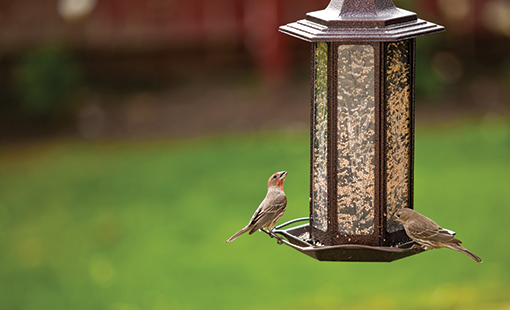
Attracting Birds to Your Yard in the Fall
Attracting and watching wild birds right in your own yard or garden are great activities year-round, but as migratory birds pass through on their way south and winter-resident species work to fatten up for the winter, autumn is a great time to think about how to support these feathered friends.
Plant Native Shrubs
You can instantly improve the attractiveness of your yard to birds in the fall by planting native shrubs. Shrubs offer two things that birds need as the weather turns colder or wetter: a food source and a place where they can find cover from the elements.
Choose native shrubs that offer berries to provide food for migratory birds as well as resident birds that stick around year-round. Include some evergreens in your garden to provide even more cover value when the weather turns cold or windy and for when precipitation (whether it’s snow or rain) is heavy.
Add A Heated Birdbath
Wild birds need water year-round and it’s easy to provide them with a simple birdbath. Birdbaths should be wide and shallow, no more than three inches deep. Birds will use the bath to get a drink and also to keep their feathers clean and in good shape.
When the temperatures drop below the freezing point water can be difficult to come by. Birds will consume snow to stay hydrated if all the liquid water is frozen, but if there’s no snow on the ground, staying hydrated in winter can be a struggle.
You can solve that by installing a heated birdbath, or by adding a heater to your existing bath. Heated birdbaths don’t make the water hot, they just keep it above the freezing point so that it stays liquid for the birds to use.
Put up a Roosting Box
A roosting box is a special kind of birdhouse that—unlike a nesting box—birds don’t use as a place to raise their young. Instead, birds use roosting boxes as places to find cover when the weather turns bad.
This different function means roosting boxes have a different design than nesting boxes. The entry hole is at the bottom rather than the top, which helps trap heat and keep the box warmer than outside temperatures (since heat rises). Roosting boxes also have perches inside to allow more birds to fill in the interior space. The more birds that pile in, the more their collective body heat helps them stay warm.
Mount the roosting box on a pole or in a tree and look in the evenings or the early morning for birds coming and going from this supplemental shelter.
Leave the Leaves
In the fall, deciduous trees and shrubs drop their leaves. In nature, these leaves protect the root zone of the plants from extreme temperatures and exposure, help retain soil moisture, suppress weeds and add nutrients back into the soil as they decompose. Fallen leaves are Mother’s Nature’s natural mulch and fertilizer.
Yet many of us spend our fall weekends raking or blowing all the leaves away. Not only is this wasteful, leaving the fallen leaves in the autumn provides a food source for birds. That’s because many insects and other invertebrates overwinter in the leaf litter. Non-migratory birds forage in the leaf litter searching for insects and spiders after it’s too cold for those invertebrates to be active.
Many butterflies and moths overwinter in the leaves as either caterpillars or pupae. In spring they emerge as adults, mate, lay eggs and produce new caterpillars. Those spring caterpillars are the primary food source for baby birds. If you remove all of your leaves this fall, you wipe out a major food pantry for the birds next year.
Put up a Feeder
Wild birds rely first on natural foods they find in the landscape, so plant lots of native plants that provide seeds and berries and the insects that birds rely on as a food source.
But there’s nothing wrong with adding a few feeders to supplement those natural foods. There are many different kinds of bird feeders. They come in different shape and sizes and some are meant for certain kinds of foods, so you’ll have a lot of options.
A good feeder should be easy to clean—regular washing is necessary to prevent spreading disease and seed spoilage—and made of durable materials such as metal, hard plastic or wood to minimize weathering or damage by squirrels.
Black oil sunflower seed is a favorite of any bird species that will visit a feeder and a great choice. You can also offer special seed blends that target different kinds of birds. Some feeders are designed to offer nuts, suet or peanut butter-based cakes, which are all high-calorie foods that can give local birds a boost in cooler months.
No matter what kind of feeder you choose, fall is a great time to add one to your yard or garden.
Information courtesy of Blog.NWF.org

 Adams Fairacre Farms
Adams Fairacre Farms